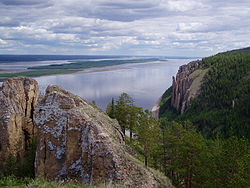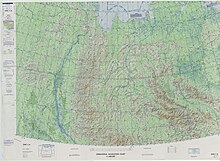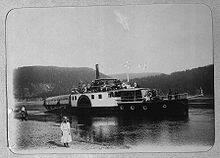| Lena | |
|---|---|
 The Lena Pillars along the river near Yakutsk The Lena Pillars along the river near Yakutsk | |
 Lena watershed Lena watershed | |
| Native name | |
| Location | |
| Country | Russia |
| Physical characteristics | |
| Source | Baikal Mountains |
| • location | Kachugsky District, Irkutsk Oblast |
| • coordinates | 53°59′40″N 107°52′33″E / 53.99444°N 107.87583°E / 53.99444; 107.87583 (approximately) |
| • elevation | 1,640 m (5,380 ft) |
| Mouth | Lena Delta |
| • location | Arctic Ocean, Laptev Sea |
| • coordinates | 72°24′31″N 126°41′05″E / 72.4087°N 126.6847°E / 72.4087; 126.6847 |
| • elevation | 0 m (0 ft) |
| Length | 4,294 km (2,668 mi) |
| Basin size | 2,460,742 km (950,098 sq mi) to 2,490,000 km (960,000 sq mi) |
| Width | |
| • maximum | 10,000 m (33,000 ft) |
| Depth | |
| • maximum | 28 m (92 ft) |
| Discharge | |
| • location | Kyusyur, Russia (Basin size: 2,440,000 km (940,000 sq mi) to 2,418,974 km (933,971 sq mi) |
| • average | (Period of data: 1971–2015)17,773 m/s (627,600 cu ft/s)
(Period of data: 1970–1999)17,067 m/s (602,700 cu ft/s) 15,500 m/s (550,000 cu ft/s) |
| • minimum | 366 m/s (12,900 cu ft/s) |
| • maximum | 241,000 m/s (8,500,000 cu ft/s)
Lena Delta, Laptev Sea, Russia (Period of data: 1984–2018)577 km/a (18,300 m/s) (Period of data: 1940–2019) 545.7 km/a (17,290 m/s) |
| Discharge | |
| • location | Vilyuy |
| • average | 12,100 m/s (430,000 cu ft/s) (Period of data: 1967–2017) 7,453.2 m/s (263,210 cu ft/s)(max. 51,600 m/s (1,820,000 cu ft/s)) |
| Discharge | |
| • location | Olyokminsk |
| • average | 4,500 m/s (160,000 cu ft/s) |
| Discharge | |
| • location | Vitim |
| • average | 1,700 m/s (60,000 cu ft/s) |
| Discharge | |
| • location | Kirensk |
| • average | 480 m/s (17,000 cu ft/s) |
| Basin features | |
| Tributaries | |
| • left | Vilyuy |
| • right | Kirenga, Vitim, Olyokma, Aldan |
The Lena is a river in the Russian Far East and is the easternmost river of the three great rivers of Siberia, including the River Ob and the River Yenisey, which flow into the Arctic Ocean. The Lena river is 4,294 km (2,668 mi) long and has a capacious drainage basin of 2,490,000 km (960,000 sq mi); thus the Lena is the eleventh-longest river in the world and the longest river entirely within Russia. Geographically, permafrost is the type of soil that underlies most of the Lena river's catchment, twenty per cent (20%) of which is continuous.
Course
The Lena river originates at 1,640 meters (5,381 ft) of elevation in the Baikal Mountains, 7 kilometres (4 mi) west of Lake Baikal, south of the Central Siberian Plateau. The Lena river flows north-east and traverses the Lena-Angara Plateau, then is joined by three tributary rivers: (i) the Kirenga river, (ii) the Vitim river, and (iii) the Olyokma river. From Yakutsk, the Lena river enters the Central Yakutian Lowland and flows north until joined by the eastern tributary, the Aldan river, and the western tributary, the Vilyuy river. Afterwards, the Lena bends westwards and northwards, flowing between the mountains of the Kharaulakh Range to the east (part of the Verkhoyansk Range) and the mountains of the Chekanovsky Ridge to the west. Travelling approximately due north, the Lena river widens into a great river delta that merges into the Laptev Sea, a marginal region of the Arctic Ocean, south-west of the New Siberian Islands. The Lena Delta is 30,000 square kilometres (12,000 sq mi) in area, being traversed by seven main branches, the most important being the Bykovsky channel, farthest east.


The Lena is navigable over a length of 3540 kilometres. The annual navigation period, when ice is minimally present or absent, lasts about 70 days in the estuarine region and 125 days elsewhere.
Basin
The area of the Lena river basin is calculated at 2,490,000 square kilometres (960,000 sq mi) and the mean annual discharge is 489 cubic kilometers per year. Gold is washed out of the sands of the Vitim and the Olyokma, and mammoth tusks have been dug out of the delta. There are numerous lakes in the floodplain of the river. Lakes Nedzheli and Ulakhan-Kyuel are the largest in the basin of the Lena.
Tributaries
The Kirenga flows north between the upper Lena River and Lake Baikal. The Vitim drains the area northeast of Lake Baikal. The Olyokma flows north. The Amga makes a long curve southeast and parallel to the Lena and flows into the Aldan. The Aldan also curves roughly parallel to the Lena until it turns east and flows into the Lena north of Yakutsk. The Maya, a tributary of the Aldan, drains an area almost to the Sea of Okhotsk. The T-shaped Chona-Vilyuy system drains most of the area to the west.
The main tributaries of the Lena are, from source to mouth:
- Tutura (right)
- Ilga (left)
- Kuta (left)
- Tayura (right)
- Kirenga (right)
- Pilyuda (left)
- Chechuy (right)
- Ichera (left)
- Chaya (right)
- Chuya (right)
- Vitim (right)
- Peleduy (left)
- Nyuya (left)
- Derba (left)
- Ura (left)
- Bolshoy Patom (right)
- Cherendey (left)
- Biryuk (left)
- Olyokma (right)
- Markha (left)
- Markhachan (left)
- Tuolba (right)
- Sinyaya (left)
- Buotama (right)
- Menda (right)
- Myla (right)
- Tamma (right)
- Lyutenge (right)
- Suola (right)
- Aldan (right)
- Batamay (right)
- Belyanka (right)
- Lyapiske (right)
- Tympylykan (left)
- Dyanyshka (right)
- Tyugyuene (left)
- Sitte (left)
- Khanchaly (left)
- Kenkeme (left)
- Lungkha (left)
- Namana (left)
- Vilyuy (left)
- Linde (left)
- Undyulyung (right)
- Nuora (left)
- Begidyan (right)
- Khoruongka (left)
- Sobolokh-Mayan (right)
- Kyuelenke (left)
- Muna (left)
- Menkere (right)
- Motorchuna (left)
- Molodo (left)
- Natara (right)
- Uel-Siktyakh (right)
- Kuranakh-Siktyakh (right)
- Byosyuke (right)
- Tikyan (right)
- Eyekit (left)
- Bulkur (left)
History
| Lena River from a source to Kachug |
|---|
| Legend |
It is commonly believed that the Lena derives its name from the original Even-Evenk name Elyu-Ene, which means "the Large River".

According to folktales related a century later, in the years 1620–1623 a party of Russian fur hunters under the leadership of Demid Pyanda sailed up Nizhnyaya Tunguska, discovered the Lena, and either carried their boats there or built new ones. In 1623 Pyanda explored some 2,400 kilometres (1,500 mi) of the river from its upper reaches to the central Yakutia. In 1628 Vasily Bugor and 10 men reached the Lena, collected 'yasak' (tribute) from the 'natives' and then founded Kirinsk in 1632. In 1631 the voyevoda of Yeniseysk sent Pyotr Beketov and 20 men to construct a fortress at Yakutsk (founded in 1632). From Yakutsk other expeditions spread out to the south and east. The Lena delta was reached in 1655.
Two of the three groups of survivors of the ill-fated Jeannette expedition reached Lena Delta in September, 1881. The one led by engineer George W. Melville was rescued by native Tungus huntsmen. Of the group led by Captain George W. De Long, only two of the men survived; the others died of starvation.
Baron Eduard Von Toll, accompanied by Alexander von Bunge, led an expedition that explored the Lena delta and the islands of New Siberia on behalf of the Russian Imperial Academy of Sciences in 1885. In 1886 they investigated the New Siberian Islands and the Yana River and its tributaries. During one year and two days the expedition covered 25,000 kilometres (16,000 mi), of which 4,200 kilometres (2,600 mi) were up rivers, carrying out geodesic surveys en route.
The Lena massacre was the name given to the 1912 shooting-down of striking goldminers and local citizens who protested at the working conditions in the mine near Bodaybo in northern Irkutsk. The incident was reported in the Duma (parliament) by Kerensky and is credited with stimulating revolutionary feeling in Russia.
Vladimir Ilyich Ulyanov may have taken his alias, Lenin, from the river Lena, when he was exiled to the Central Siberian Plateau.
Delta


At the end of the Lena River there is a large delta that extends 100 kilometres (62 mi) into the Laptev Sea and is about 400 km (250 mi) wide. The delta is frozen tundra for about seven months of the year, but in May the region is transformed into a lush wetland for a few months. Part of the area is protected as the Lena Delta Wildlife Reserve.
The Lena delta divides into a multitude of flat islands. The most important are (from west to east): Chychas Aryta, Petrushka, Sagastyr, Samakh Ary Diyete, Turkan Bel'keydere, Sasyllakh Ary, Kolkhoztakh Bel'keydere, Grigoriy Diyelyakh Bel'kee (Grigoriy Islands), Nerpa Uolun Aryta, Misha Bel'keydere, Atakhtay Bel'kedere, Arangastakh, Urdiuk Pastakh Bel'key, Agys Past' Aryta, Dallalakh Island, Otto Ary, Ullakhan Ary and Orto Ues Aryta.
Turukannakh-Kumaga is a long and narrow island off the Lena delta's western shore.
One of the Lena delta islands, Ostrov Amerika-Kuba-Aryta or Ostrov Kuba-Aryta, was named after the island of Cuba during Soviet times. It is on the northern edge of the delta.
Fish
As Lena is located at remote and undeveloped regions of the Russian Far East, its fish resource is very well preserved. Some of the species found in the river include: Siberian taimen, Siberian sturgeon, Upper Yenisei grayling.
Further reading
- Gautier, Emmanuèle; Costard, François; Fedorov, Alexander (2022). "The Lena: A Large River in a Deep Permafrost Zone". Large Rivers. pp. 320–334. doi:10.1002/9781119412632.ch11. ISBN 978-1-119-41260-1.
- Alexander von Bunge & Eduard von Toll (1887), The Expedition to the New Siberian Islands and the Yana country, equipped by the Imperial Academy of Sciences.
- Jeffrey Tayler (2006), River of No Reprieve: Descending Siberia's Waterway of Exile, Death, and Destiny
See also
- Lena Cheeks
- Lena Pillars
- Lena Plateau
- List of rivers of Russia
- List of longest undammed rivers
- Tukulan
- William Barr, writer of The First Soviet Convoy to the Mouth of the Lena.
 Siberia portal
Siberia portal
Notes
- Russian: Ле́на, IPA: [ˈlʲɛnə]; Evenki: Елюенэ, Eljujene; Yakut: Өлүөнэ, Ölüöne; Buryat: Зүлхэ, Zülkhe; Mongolian: Зүлгэ, Zülge
References
- ^ Stadnyk, Tricia A.; Tefs, A.; Broesky, M.; Déry, S. J.; Myers, P. G.; Ridenour, N. A.; Koenig, K.; Vonderbank, L.; Gustafsson, D. (28 May 2021). "Changing freshwater contributions to the Arctic". Elementa: Science of the Anthropocene. 9 (1): 00098. Bibcode:2021EleSA...9...98S. doi:10.1525/elementa.2020.00098. S2CID 236682638.
- "Variations of the Present-Day Annual and Seasonal Runoff in the Far East and Siberia with the Use of Regional Hydrological and Global Climate Models" (PDF). 2018.
- http://www.abratsev.narod.ru/biblio/sokolov/p1ch23b.html, Sokolov, Eastern Siberia // Hydrography of USSR. (in russian)
- "River Discharge".
- ^ Gautier, Emmanuèle; Dépret, Thomas; Cavero, Julien; Costard, François; Virmoux, Clément; Fedorov, Alexander; Konstantinov, Pavel; Jammet, Maël; Brunstein, Daniel (August 2021). "Fifty-year dynamics of the Lena River islands (Russia): Spatio-temporal pattern of large periglacial anabranching river and influence of climate change". Science of the Total Environment. 783: 147020. Bibcode:2021ScTEn.78347020G. doi:10.1016/j.scitotenv.2021.147020. PMID 34088165. S2CID 234836524.
- "Река Лена in the State Water Register of Russia". textual.ru (in Russian).
- "Lena River Delta - A Global Ecoregion". World Wide Fund for Nature. 2006-07-06. Archived from the original on 2007-06-30. Retrieved 2008-05-23.
- Kim, Yu-Na; Krasilnikova, Niurgustana; Choi, Young-Seo; Yeo, Gi-Tae (June 2023). "Structural analysis of factors for revitalizing lena river logistics using ISM method". The Asian Journal of Shipping and Logistics. 39 (2): 46–51. doi:10.1016/j.ajsl.2023.02.001.
- "Открытие русскими Средней и Восточной Сибири". www.randewy.ru. Retrieved 4 April 2018.
- "Google Maps". Google Maps. Retrieved 4 April 2018.
- Rose-Innes, Keith (12 May 2020). "The Taimen of Russia's Tugur River". Fly Fisherman. Retrieved 22 March 2024.
- Kirillov, A. F.; Knizhin, I. B. (August 2014). "Ichthyofauna of the Lena River (Laptev Sea Basin): Modern composition and historical formation". Journal of Ichthyology. 54 (7): 433–445. Bibcode:2014JIch...54..433K. doi:10.1134/S0032945214040031.
 This article incorporates text from a publication now in the public domain: Chisholm, Hugh, ed. (1911). "Lena". Encyclopædia Britannica. Vol. 16 (11th ed.). Cambridge University Press.
This article incorporates text from a publication now in the public domain: Chisholm, Hugh, ed. (1911). "Lena". Encyclopædia Britannica. Vol. 16 (11th ed.). Cambridge University Press.
External links
 Media related to Lena (river) at Wikimedia Commons
Media related to Lena (river) at Wikimedia Commons- Arctic Great Rivers Observatory (ArcticGRO)
- NASA Earth Observatory page on flooding on the Lena River
- Information and a map of the Lena's watershed
- Permafrost in the Lena Delta
- Alfred Wegner institute (AWI) Publications, Berichte zur Polar- und Meeresforschung (Reports on polar and marine research) - free, downloadable research reports on the biology, geology, oceanography, hydrology, paleontology, paleoclimatology, fauna, flora, soils, cryology, and so forth of the Lena Delta, Laptev Sea, and other parts of the Arctic Circle.
| Shipbuilding and shipping on the river Lena | |||||||
|---|---|---|---|---|---|---|---|
| Shipbuilding |
| ||||||
| River ports |
| ||||||
| Ship types | |||||||
| Well-known vessels | |||||||
| Well-known travels | |||||||
| River accidents | |||||||
| Significant persons |
| ||||||